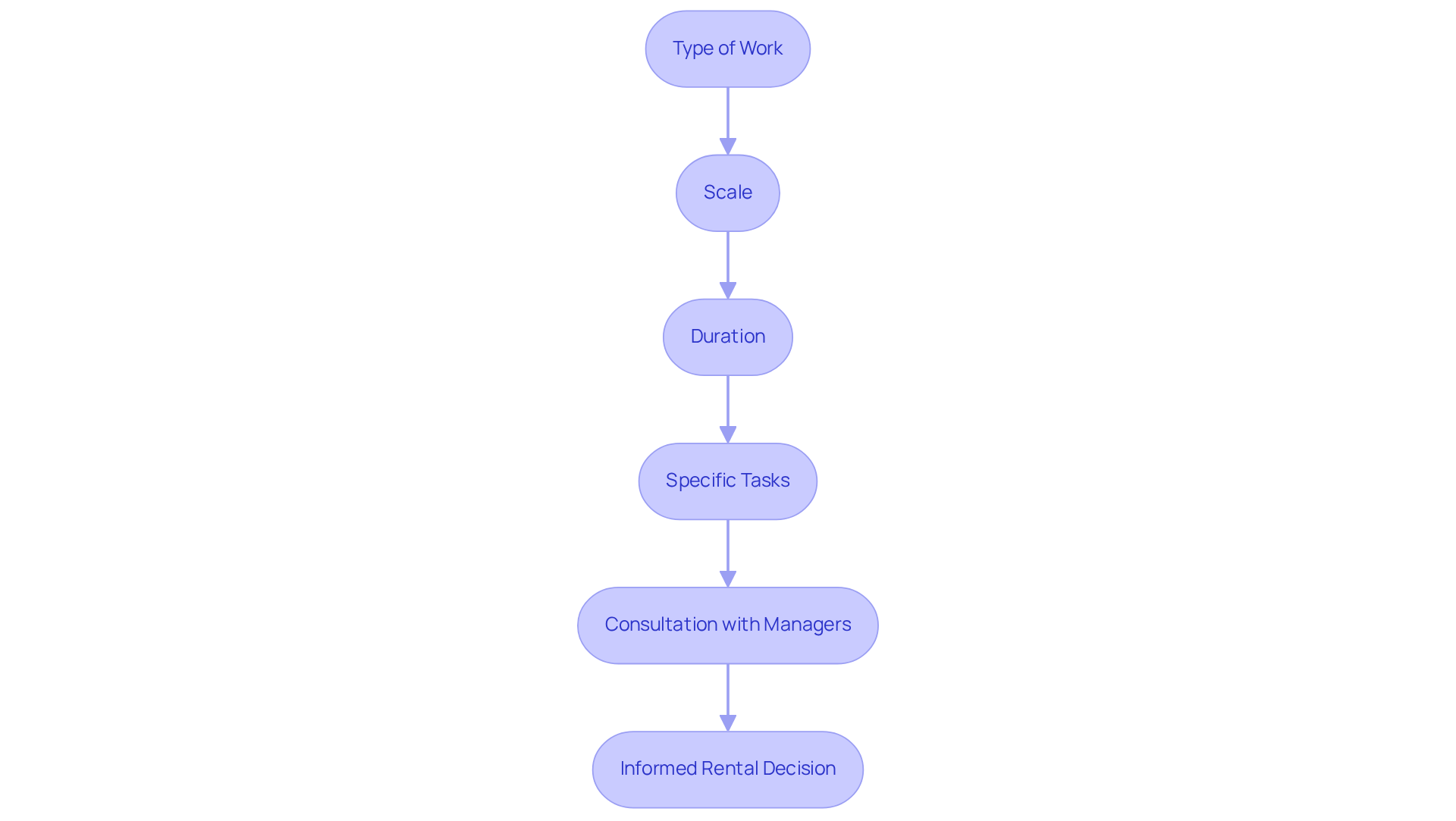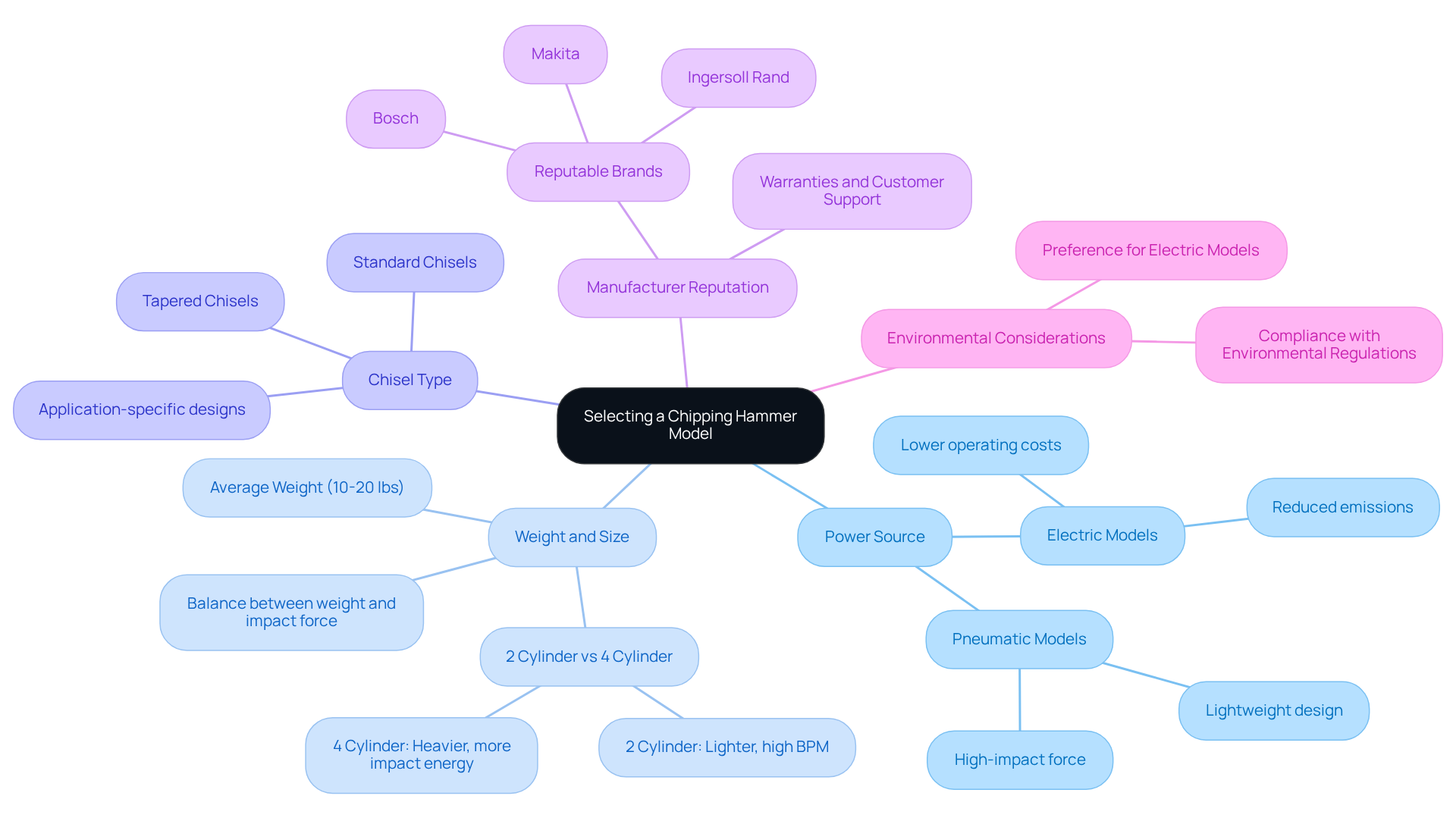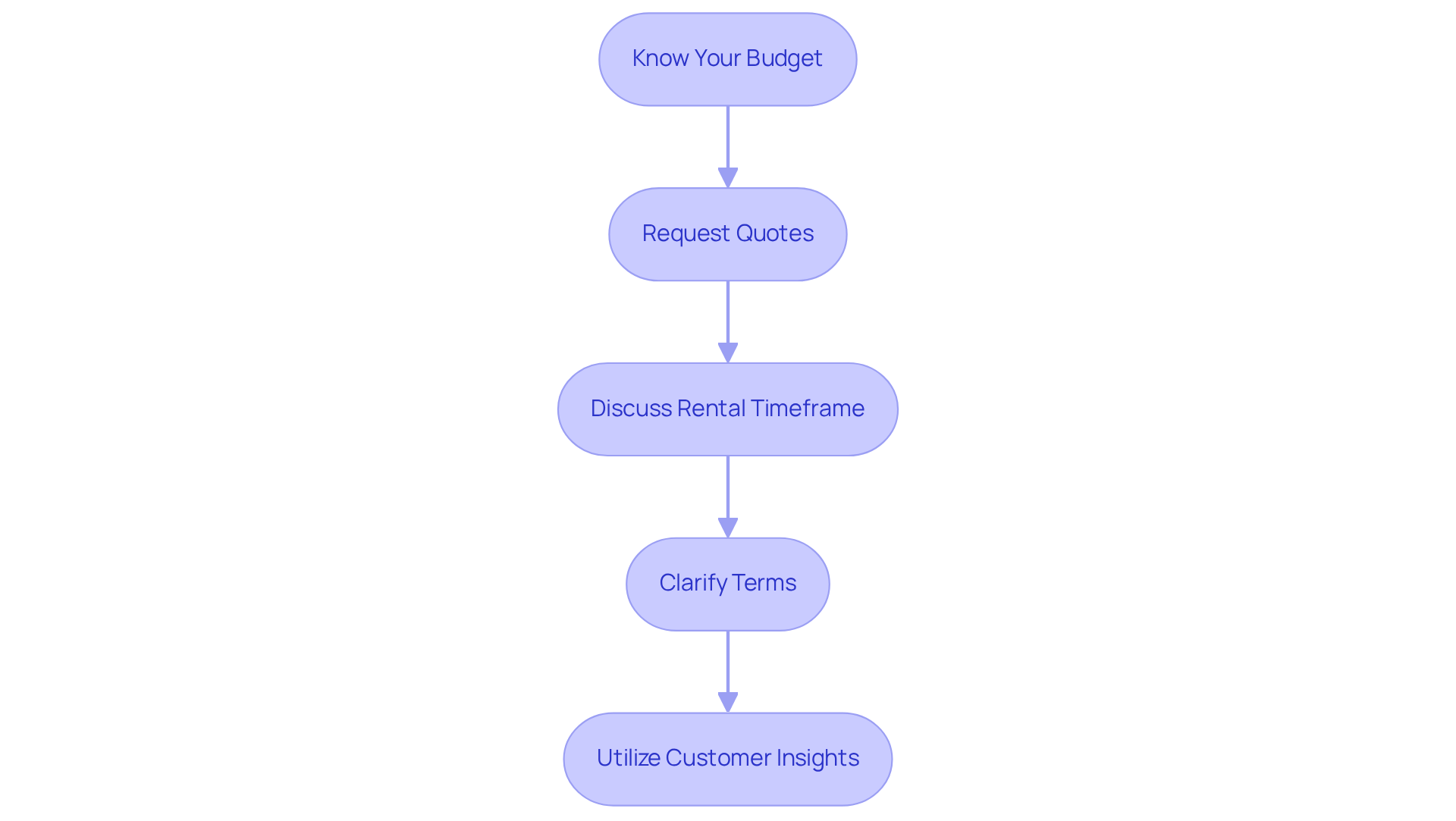Overview
To effectively rent a chipping hammer for your construction project, it is essential to evaluate your project needs. Begin by:
- Choosing a reputable rental company that offers quality equipment.
- Selecting the appropriate model that aligns with your specific requirements.
- Negotiating rental terms that are favorable and adhere to safety guidelines throughout the process.
This article provides a comprehensive guide detailing each step, emphasizing the importance of understanding project requirements and safety protocols to ensure efficient equipment use and minimize risks on the job site.
Key Highlights:
- Evaluate project needs by considering type of work, scale, duration, and specific tasks to determine equipment requirements.
- Engage experienced supervisors to gather insights on equipment selection for construction projects.
- Research and choose a reputable equipment rental company based on customer feedback and service quality.
- Cheque the rental company's inventory to ensure they have the necessary equipment for your project.
- Select a chipping hammer based on power source (pneumatic vs electric), weight, chisel type, and manufacturer reputation.
- Negotiate rental terms by understanding your budget, requesting quotes, and discussing rental timeframes for potential discounts.
- Review safety guidelines including PPE usage, operational instructions, work area safety, and regular equipment inspections to prevent accidents.
Introduction
Navigating the world of construction equipment rental can be a daunting task, particularly when selecting the right tools for a project. With the rising demand for efficient and reliable machinery, understanding the process of renting a chipping hammer is essential for any construction endeavor. This guide outlines crucial steps to ensure that project managers and contractors secure the right equipment and optimize their rental experience. Challenges may arise during the rental process; however, effectively addressing these issues can prevent costly setbacks.
Identify Your Project Needs and Requirements
Begin by thoroughly evaluating the scope of your building endeavor, as this will significantly influence your equipment rental choices. Consider the following factors:
- Type of Work: Determine whether your project involves demolition, renovation, or new construction. Each type has distinct specifications for rent chipping hammer, which will impact your decision.
- Scale: Assess the magnitude of your endeavor. Larger tasks typically require more robust machinery to effectively manage increased workloads. For instance, projects exceeding 10,000 square feet often necessitate the use of a rent chipping hammer, which is an industrial-grade tool typically weighing between 15 to 30 pounds and offering varying levels of impact energy to sustain productivity.
- Duration: Estimate the borrowing period for the rent chipping hammer. Understanding how long you will need the equipment is crucial for negotiating favorable rental terms and ensuring you have the right tools for the job.
- Specific Tasks: Clearly define the tasks the rent chipping hammer will perform, such as breaking concrete or removing tiles. This clarity will aid in selecting the most suitable model, ensuring it meets the requirements of your project.
- Consultation with Managers: Engage with experienced supervisors in the building sector to gather insights on determining equipment needs. Their expertise can provide valuable guidance on the nuances of equipment selection based on scope and size.
By carefully considering these elements, you can make informed decisions that align with your project's needs, ultimately enhancing efficiency and reducing the risk of costly rework, which can account for 9% to 12% of overall construction costs. At EZ Equipment Rental, we prioritize dependability and exceptional customer service, ensuring that you receive expert assistance throughout your leasing experience.

Find a Reputable Equipment Rental Company
To find a reputable equipment rental company, follow these essential steps:
- Research Online: Begin your search using search engines and review sites to identify local rental companies. Prioritize those with positive customer feedback, particularly those that emphasize hassle-free solutions, such as EZ Equipment Rental, which manages maintenance and storage on your behalf.
- Ask for Recommendations: Consult with colleagues or industry contacts who have experience renting equipment, especially from companies recognized for exceptional customer service and support. Their insights can guide you toward reliable options.
- Check Inventory: Ensure the company offers a diverse selection of equipment, including rent chipping hammer, boom lifts, excavators, and forklifts, to meet your specific project requirements. A well-stocked inventory is crucial for timely project execution.
- Evaluate Customer Service: Reach out to the company to gauge their responsiveness and willingness to assist with your inquiries. A commitment to customer satisfaction is vital in the equipment leasing sector, and this interaction can reveal their dedication to service.
- Consider Local Availability: Confirm that the leasing company operates within your area. For instance, EZ Equipment Rental provides services across the DFW Metroplex, ensuring you have timely access to the equipment you need.
By following these steps, you can confidently select a trustworthy equipment rental company that aligns with your needs and expectations.

Select the Appropriate Chipping Hammer Model
When selecting a rent chipping hammer for your construction project, several key factors must be considered to ensure optimal performance and efficiency.
-
Power Source: Choose between pneumatic and electric models based on your project requirements and the availability of power sources. Pneumatic tools are favored for their high-impact force and lightweight design, making them ideal for demolition tasks. However, electric models are gaining popularity due to their lower operating costs and reduced emissions, making them suitable for both professional and DIY applications. Significantly, the pneumatic chipping tool market was valued at USD 150 million in 2024 and is anticipated to expand to USD 250 million by 2033, indicating the rising demand for these instruments in construction.
-
Weight and Size: The average weight of chipping tools typically ranges from 10 to 20 pounds. Lighter models are easier to handle but may deliver less impact energy. It is essential to choose a tool that strikes a balance between weight and impact force to effectively meet your project's demands. For example, a 2" cylinder chipping tool is lighter and provides less impact energy but has a high BPM, while a 4" cylinder is heavier, offers more impact energy, and has a lower BPM.
-
Chisel Type: Different chisels are designed for specific applications, such as concrete breaking or surface preparation. Ensure that the chipping tool you select can accommodate the chisel types necessary for your tasks, whether they are tapered or standard.
-
Manufacturer Reputation: Opt for reputable brands known for their quality and reliability, such as Ingersoll Rand, Bosch, and Makita. These manufacturers often provide warranties and customer support, ensuring you have assistance if needed. As noted by industry leaders, selecting the right power source and model is crucial for maximizing efficiency and safety on the job site.
-
Environmental Considerations: With increasing environmental regulations, there is a growing preference for electric models due to their reduced emissions. This trend aligns with the building sector's focus on sustainability and responsible practices.
By carefully considering these factors, you can select the most appropriate rent chipping hammer model that aligns with your construction project needs. Take action now to ensure you have the right tools for success.

Negotiate Rental Terms and Pricing
To negotiate rental terms and pricing effectively, it is crucial to adopt a strategic approach that will empower you throughout the process.
-
Know Your Budget: Establish a clear understanding of your budget constraints before entering negotiations. This foundational step will guide your discussions and help you avoid overspending, allowing you to focus on securing the best possible deal.
-
Request Quotes: Obtain quotes from various leasing companies to compare prices and terms. This competitive approach not only leads to better deals but also provides valuable insights into market rates, enhancing your negotiating position.
-
Discuss Rental Timeframe: Inquire about discounts for longer leasing periods, as many companies offer incentives for extended agreements. Statistics indicate that the typical lease period for machinery is around two weeks, which can result in higher profitability for leasing companies. This insight makes it a valuable negotiation point to leverage.
-
Clarify Terms: Ensure you fully understand all terms, including delivery fees, insurance, and maintenance responsibilities. Don't hesitate to ask for adjustments if needed; clarity can prevent unexpected costs later. Emphasizing the importance of understanding specific fees and responsibilities can help avoid hidden costs, ultimately protecting your budget.
-
Utilize Customer Insights: Take into account feedback from project managers regarding budgeting for equipment leases. For example, one building manager remarked, "Comprehending the total cost of ownership compared to rental expenses is essential for efficient budgeting." Their experiences can provide valuable perspectives on effective negotiation strategies and common pitfalls to avoid, enhancing your overall approach.

Review Safety Guidelines and Operational Instructions
Before using the chipping hammer, it is imperative to adhere to the following safety guidelines to ensure a safe working environment:
-
Personal Protective Equipment (PPE): Always wear appropriate PPE, including safety goggles, gloves, and hearing protection. It is noteworthy that nearly 60% of workers in the building sector utilize PPE; however, many still face risks due to discomfort and insufficient understanding of correct usage. Equipping all operators with the right PPE is crucial, as falls, slips, and trips accounted for 35.3% of workplace deaths in construction in 2020. Furthermore, 64.3% of workers reported experiencing occupational accidents in the last 12 months, underscoring the need for effective safety measures.
-
Operational Instructions: Familiarize yourself with the manufacturer's operational instructions to ensure proper use. Understanding the equipment's functionality can significantly reduce the risk of accidents.
-
Work Area Safety: Clear the work area of obstacles and ensure it is well-lit. Securing the area to prevent unauthorized access is essential, as many accidents stem from unsafe environments and behaviors.
-
Regular Inspections: Conduct thorough checks on the chipping tool for any signs of wear or damage before use. Ensuring that all safety features are functional can prevent incidents that may arise from equipment failure. Notably, safety training has been identified as a significant predictor of PPE use, which in turn reduces the likelihood of accidents. In fact, 91% of contractors currently have training programs on PPE, highlighting the importance of ongoing education.
Training and awareness should include providing instruction on the correct use of PPE and the rent chipping hammer itself. Safety professionals emphasize that a well-informed workforce is less likely to experience accidents, which underscores the importance of ongoing safety education in the construction industry. As Jonny Finity noted, "It is increasingly important to create a culture of safety and reduce the risk of workplace accidents.

Conclusion
Renting a chipping hammer for a construction project is a process that demands careful consideration and planning. By understanding the specific needs of the project, selecting the right rental company, and negotiating favorable terms, you can ensure that the right tools are available to enhance productivity and efficiency. The significance of safety and adherence to proper operational guidelines cannot be overstated, as they play a critical role in maintaining a secure work environment.
Key insights emphasize the necessity of evaluating project requirements, such as the type of work and scale, to make informed equipment choices. Finding a reputable rental company that offers a diverse inventory and exceptional customer service is equally crucial. Additionally, selecting the appropriate chipping hammer model based on power source, weight, and chisel type can significantly impact project outcomes. Effectively negotiating rental terms and adhering to safety guidelines further contribute to a successful rental experience.
In conclusion, taking the time to assess project needs, research rental options, and prioritize safety can lead to a smoother construction process. By following these outlined steps, individuals can maximize the benefits of renting a chipping hammer, ultimately driving project success and minimizing potential risks. Embracing these best practices not only ensures the right tools are in place but also fosters a culture of safety and efficiency on the job site.
Frequently Asked Questions
What should I consider when identifying my project needs and requirements for equipment rental?
You should evaluate the type of work (demolition, renovation, or new construction), scale of the project, duration of equipment use, specific tasks the equipment will perform, and consult with experienced managers in the building sector for insights.
How does the scale of my project influence equipment rental choices?
Larger projects typically require more robust machinery to manage increased workloads. For example, projects exceeding 10,000 square feet often need industrial-grade tools like a rent chipping hammer.
Why is it important to estimate the duration for renting equipment?
Estimating the borrowing period is crucial for negotiating favorable rental terms and ensuring you have the right tools for the job during the required timeframe.
What specific tasks should I define when renting a chipping hammer?
You should clearly define tasks such as breaking concrete or removing tiles, which will help in selecting the most suitable model for your project.
How can I find a reputable equipment rental company?
Start by researching online for local rental companies with positive feedback, ask for recommendations from colleagues, check the company's inventory for diverse equipment options, evaluate their customer service responsiveness, and confirm their local availability.
What types of equipment should a reputable rental company offer?
A reputable rental company should offer a diverse selection of equipment, including rent chipping hammers, boom lifts, excavators, and forklifts to meet your project requirements.
Why is customer service important when selecting an equipment rental company?
Good customer service is vital as it indicates the company's commitment to customer satisfaction and can significantly affect your overall rental experience.
What benefits does EZ Equipment Rental provide?
EZ Equipment Rental emphasizes dependability and exceptional customer service, managing maintenance and storage on behalf of clients, and offers services across the DFW Metroplex for timely access to equipment.




